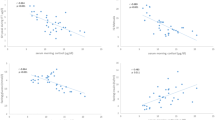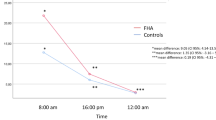Abstract
Background and aim
A close relationship between adiposity and increased cortisol levels is well established in patients with endogenous hypercortisolism. Nevertheless, hypothalamic-pituitary-adrenal (HPA) axis regulation in overweight subjects is still a matter of concern. We studied free cortisol (urinary free cortisol, UFC and late night salivary cortisol, LNSC), pituitary feedback (serum cortisol after 1 mg dexamethasone suppression test, 1 mg DST) and peripheral cortisol metabolism (urinary cortisol to cortisone ratio, F/Eratio) in a large series of overweight subjects without Cushing’s Syndrome.
Materials and methods
We considered 234 patients divided in 5 BMI classes, matched for age and gender (BMI ≤ 25 kg/m2n = 38; 25–30 n = 58; 30–35 n = 52; 35–40 n = 52; >40 n = 34). UFC, LNSC and urinary F/Eratio were assessed with LC-MS.
Results
We collected 183 LNSC, 176 UFC, 152 1 mg DST and 64 F/Eratio tests. UFC levels were higher in lean subjects, and they decreased according to the BMI classes (p = 0.022). Non-suppressed cortisol levels (>50 nmol/L) after 1 mg DST were observed especially in patients with normal weight or mild obesity. Patients with BMI ≥ 35 kg/m2 revealed a reduced F/Eratio (0.39 vs. 0.61, p = 0.006). The specificity of tests (false positive results) was higher considering 1 mg DST or UFC in obese patients, on the contrary impaired cortisol rhythm (LNSC above normality) was observed in 47 subjects, irrespective of weight.
Conclusions
Overweight and obese subjects are characterised by an original regulation of HPA axis (reduced UFC levels, increased suppression after 1 mg DST) and peripheral cortisol metabolism (reduced F/Eratio), suggesting an effort to counteract hypercortisolism.



Similar content being viewed by others
Data availability
Data are available on request due to local (academic) restrictions.
References
A.C. Incollingo Rodriguez, E.S. Epel, M.L. White, E.C. Standen, J.R. Seckl, A.J. Tomiyama, Hypothalamic-pituitary-adrenal axis dysregulation and cortisol activity in obesity: a systematic review. Psychoneuroendocrinology. 62, 301–318 (2015). https://doi.org/10.1016/j.psyneuen.2015.08.014
L. Plat, R. Leproult, M. L’Hermite-Baleriaux et al. Metabolic effects of short-term elevations of plasma cortisol are more pronounced in the evening than in the morning 1. J. Clin. Endocrino.l Metab. 84(9), 3082–3092 (1999). https://doi.org/10.1210/jcem.84.9.5978
M. Boscaro, G. Arnaldi, Approach to the patient with possible cushing’s syndrome. J. Clin. Endocrinol. Metab. 94(9), 3121–3131 (2009). https://doi.org/10.1210/jc.2009-0612
F. Ceccato, M. Boccato, M. Zilio et al. Body composition is different after surgical or pharmacological remission of cushing’s syndrome: a prospective DXA study. Horm. Metab. Res. 49(9) (2017). https://doi.org/10.1055/s-0043-115008
K.I. Alexandraki, A.B. Grossman, Is urinary free cortisol of value in the diagnosis of Cushing’s syndrome? Curr. Opin. Endocrinol. Diabetes Obes. 18(4), 259–263 (2011). https://doi.org/10.1097/MED.0b013e3283487193
M.B. Elamin, M.H. Murad, R. Mullan et al. Accuracy of diagnostic tests for cushing’s syndrome: a systematic review and metaanalyses. J. Clin. Endocrinol. Metab. 93(5), 1553–1562 (2008). https://doi.org/10.1210/jc.2008-0139
F. Ceccato, M. Barbot, M. Zilio et al. Screening tests for cushing’s syndrome: urinary free cortisol role measured by LC-MS/MS. J. Clin. Endocrinol. Metab. 100(10) (2015). https://doi.org/10.1210/jc.2015-2507
P.M. Stewart, A. Boulton, S. Kumar, P.M.S. Clark, C.H.L. Shackleton, Cortisol metabolism in human obesity: impaired cortisone→cortisol conversion in subjects with central adiposity 1. J. Clin. Endocrinol. Metab. 84(3), 1022–1027 (1999). https://doi.org/10.1210/jcem.84.3.5538
E. Rask, T. Olsson, S. Söderberg et al. Tissue-specific dysregulation of cortisol metabolism in human obesity. J. Clin. Endocrinol. Metab. 86(3), 1418–1421 (2001). https://doi.org/10.1210/jcem.86.3.7453
E. Rask, B.R. Walker, S. Söderberg et al. Tissue-specific changes in peripheral cortisol metabolism in obese women: increased adipose 11beta-hydroxysteroid dehydrogenase type 1 activity. J. Clin. Endocrinol. Metab. 87(7), 3330–3336 (2002). https://doi.org/10.1210/jcem.87.7.8661
V. Vicennati, R. Pasquali, Abnormalities of the hypothalamic-pituitary-adrenal axis in nondepressed women with abdominal obesity and relations with insulin resistance: evidence for a central and a peripheral alteration. J. Clin. Endocrinol. Metab. 85(11), 4093–4098 (2000). https://doi.org/10.1210/jcem.85.11.6946
L.K. Nieman, B.M.K. Biller, J.W. Findling et al. The diagnosis of cushing’s syndrome: an endocrine society clinical practice guideline. J. Clin. Endocrinol. Metab. 93(5), 1526–1540 (2008). https://doi.org/10.1210/jc.2008-0125
M. Fassnacht, W. Arlt, I. Bancos et al. Management of adrenal incidentalomas: european society of endocrinology clinical practice guideline in collaboration with the european network for the study of adrenal tumors. Eur. J. Endocrinol. 175(2), G34 (2016). https://doi.org/10.1530/EJE-16-0467
T. Ljung, M. Ottosson, A.C. Ahlberg et al. Central and peripheral glucocorticoid receptor function in abdominal obesity. J Endocrinol. Investig. 25(3), 229–235 (2002). https://doi.org/10.1007/BF03343995
R. Pasquali, B. Ambrosi, D. Armanini et al. Cortisol and ACTH response to oral dexamethasone in obesity and effects of sex, body fat distribution, and dexamethasone concentrations: a dose-response study. J. Clin. Endocrinol. Metab. 87(1), 166–175 (2002). https://doi.org/10.1210/jcem.87.1.8158
H. Raff, Cushing’s syndrome: diagnosis and surveillance using salivary cortisol. Pituitary. 15(1), 64–70 (2012). https://doi.org/10.1007/s11102-011-0333-0
T. Deutschbein, M. Broecker-Preuss, J. Flitsch et al. Salivary cortisol as a diagnostic tool for Cushing’s syndrome and adrenal insufficiency: improved screening by an automatic immunoassay. Eur. J. Endocrinol. 166(4), 613 (2012). https://doi.org/10.1530/EJE-11-0945
G. Antonelli, F. Ceccato, C. Artusi, M. Marinova, M. Plebani, Salivary cortisol and cortisone by LC-MS/MS: validation, reference intervals and diagnostic accuracy in Cushing’s syndrome. Clin. Chim. Acta. 451 (2015). https://doi.org/10.1016/j.cca.2015.10.004
S.B. Abraham, D. Rubino, N. Sinaii, S. Ramsey, L.K. Nieman, Cortisol, obesity, and the metabolic syndrome: a cross-sectional study of obese subjects and review of the literature. Obesity. 21(1), E105–E117 (2013). https://doi.org/10.1002/oby.20083
F. Ceccato, M. Barbot, M. Zilio et al. Age and the metabolic syndrome affect salivary cortisol rhythm: data from a community sample. Hormones. 14(3) (2015). https://doi.org/10.14310/horm.2002.1591
F. Ceccato, G. Marcelli, M. Martino et al. The diagnostic accuracy of increased late night salivary cortisol for Cushing’s syndrome: a real-life prospective study. J. Endocrinol. Investig. 1–9 (2018). https://doi.org/10.1007/s40618-018-0921-1
B. MARINIELLO, V. RONCONI, C. SARDU et al. Analysis of the 11β-Hydroxysteroid Dehydrogenase Type 2 Gene (HSD11B2) in human essential hypertension. Am. J. Hypertens. 18(8), 1091–1098 (2005). https://doi.org/10.1016/j.amjhyper.2005.02.020
P. Limumpornpetch, P. M. Stewart. Apparent Mineralocorticoid Excess. In: I Huhtaniemi, (ed.) Encyclopedia of Endocrine Diseases. 3, Academic Press, Elsevier; 638–643 (2018). https://doi.org/10.1016/B978-0-12-801238-3.64338-6. https://www.elsevier.com/books/encyclopedia-of-endocrine-diseases/huhtaniemi/978-0-12-812199-3
R. Pasquali, V. Vicennati, M. Cacciari, U. Pagotto, The hypothalamic-pituitary-adrenal axis activity in obesity and the metabolic syndrome. Ann. N. Y. Acad. Sci. 1083, 111–128 (2006). https://doi.org/10.1196/annals.1367.009
J.W. Findling, H. Raff, O.F. DIAGNOSIS, Endocrine disease: differentiation of pathologic/neoplastic hypercortisolism (Cushing’s syndrome) from physiologic/non-neoplastic hypercortisolism (formerly known as pseudo-Cushing’s syndrome). Eur. J. Endocrinol. 176(5), R205–R216 (2017). https://doi.org/10.1530/EJE-16-0946
C. Scaroni, N.M. Albiger, S. Palmieri et al. Approach to patients with pseudo-Cushing’s states. Endocr. Connect. 9(1), R1–R13 (2020). https://doi.org/10.1530/EC-19-0435
World Health Organization. Obesity: preventing and managing the global epidemic report of a WHO consultation (WHO Technical Report Series 894). Geneva, 2000. https://www.who.int/nutrition/publications/obesity/WHO_TRS_894/en/
F. Ceccato, G. Antonelli, M. Barbot et al. The diagnostic performance of urinary free cortisol is better than the cortisol: cortisone ratio in detecting de novo Cushing’s Syndrome: The use of a LC-MS/MS method in routine clinical practice. Eur. J. Endocrinol. 171(1) (2014). https://doi.org/10.1530/EJE-14-0061
F. Ceccato, M. Barbot, N. Albiger et al. Daily salivary cortisol and cortisone rhythm in patients with adrenal incidentaloma. Endocrine. 2017. https://doi.org/10.1007/s12020-017-1421-3
F. Ceccato, C. Artusi, M. Barbot et al. Dexamethasone measurement during low-dose suppression test for suspected hypercortisolism: threshold development with and validation. J. Endocrinol. Investig. 2020. https://doi.org/10.1007/s40618-020-01197-6
F. Pecori Giraldi, A.G. Ambrogio, M. De Martin, L.M. Fatti, M. Scacchi, F. Cavagnini, Specificity of first-line tests for the diagnosis of cushing’s syndrome: assessment in a large series. J. Clin. Endocrinol. Metab. 92(11), 4123–4129 (2007). https://doi.org/10.1210/jc.2007-0596
S.K. Baid, D. Rubino, N. Sinaii, S. Ramsey, A. Frank, L.K. Nieman, Specificity of screening tests for cushing’s syndrome in an overweight and obese population. J. Clin. Endocrinol. Metab. 94(10), 3857–3864 (2009). https://doi.org/10.1210/jc.2008-2766
A. Drincic, E. Fuller, R.P. Heaney, L.A.G. Armas, 25-Hydroxyvitamin D response to graded vitamin D3 supplementation among obese adults. J. Clin. Endocrinol. Metab. 98(12), 4845–4851 (2013). https://doi.org/10.1210/jc.2012-4103
V. Camozzi, A.C. Frigo, M. Zaninotto et al. 25-Hydroxycholecalciferol response to single oral cholecalciferol loading in the normal weight, overweight, and obese. Osteoporos Int. 27(8), 2593–2602 (2016). https://doi.org/10.1007/s00198-016-3574-y
S. Hepsen, E. Sencar, D. Sakiz et al. Serum cortisol level after low dose dexamethasone suppression test may be predictive for diabetes mellitus and hypertension presence in obese patients: a retrospective study. Diabetes Res. Clin. Pract. 161, 108081 (2020). https://doi.org/10.1016/j.diabres.2020.108081
G.W. Strain, B. Zumoff, J.J. Strain, J. Levin, D.K. Fukushima, Cortisol production in obesity. Metabolism. 29(10), 980–985 (1980). http://www.ncbi.nlm.nih.gov/pubmed/6999293
T.G. Travison, A.B. O’Donnell, A.B. Araujo, A.M. Matsumoto, J.B. McKinlay, Cortisol levels and measures of body composition in middle-aged and older men. Clin. Endocrinol (Oxf). 67(1), 71–77 (2007). https://doi.org/10.1111/j.1365-2265.2007.02837.x
V. Vicennati, S. Garelli, E. Rinaldi, G. Di Dalmazi, U. Pagotto, R. Pasquali, Cross-talk between adipose tissue and the HPA axis in obesity and overt hypercortisolemic states. Horm. Mol. Biol. Clin. Investig. 17(2), 63–77 (2014). https://doi.org/10.1515/hmbci-2013-0068
C.P. Woods, M. Corrigan, L. Gathercole et al. Tissue specific regulation of glucocorticoids in severe obesity and the response to significant weight loss following bariatric surgery (BARICORT). J. Clin. Endocrinol. Metab. 100(4), 1434–1444 (2015). https://doi.org/10.1210/jc.2014-4120
I. Chiodini, A. Gaudio, C. Eller-Vainicher et al. Cortisol secretion, sensitivity, and activity are associated with hypertension in postmenopausal eucortisolemic women. J. Clin. Endocrinol. Metab. 104(10), 4441–4448 (2019). https://doi.org/10.1210/jc.2019-00037
S. Champaneri, X. Xu, M.R. Carnethon et al. Diurnal salivary cortisol is associated with body mass index and waist circumference: the multiethnic study of atherosclerosis. Obesity. 21(1), E56–E63 (2013). https://doi.org/10.1002/oby.20047
S. Coelli, C.B. Farias, A.A. Soares et al. Influence of age, gender and body mass index on late-night salivary cortisol in healthy adults. Clin. Chem. Lab. Med. 55(12), 1954–1961 (2017). https://doi.org/10.1515/cclm-2016-1100
Author information
Authors and Affiliations
Corresponding author
Ethics declarations
Conflict of interest
The authors declare that they have no conflict of interest.
Additional information
Publisher’s note Springer Nature remains neutral with regard to jurisdictional claims in published maps and institutional affiliations.
Rights and permissions
About this article
Cite this article
Ceccato, F., Lizzul, L., Barbot, M. et al. Pituitary-adrenal axis and peripheral cortisol metabolism in obese patients. Endocrine 69, 386–392 (2020). https://doi.org/10.1007/s12020-020-02392-4
Received:
Accepted:
Published:
Issue Date:
DOI: https://doi.org/10.1007/s12020-020-02392-4




